
A steamboat is a boat that is propelled primarily by steam power, typically driving propellers or paddlewheels. Steamboats sometimes use the prefix designation SS, S.S. or S/S or PS ; however, these designations are most often used for steamships.

A pusher, pusher craft, pusher boat, pusher tug, or towboat, is a boat designed for pushing barges or car floats. In the United States, the industries that use these vessels refer to them as towboats. These vessels are characterized by a square bow, a shallow draft, and typically have knees, which are large plates mounted to the bow for pushing barges of various heights. These boats usually operate on rivers and inland waterways. Multiple barges lashed together, or a boat and any barges lashed to it, are referred to as a "tow" and can have dozens of barges. Many of these vessels, especially the long distances, or long haul boats, include living quarters for the crew.

A paddle steamer is a steamship or steamboat powered by a steam engine that drives paddle wheels to propel the craft through the water. In antiquity, paddle wheelers followed the development of poles, oars and sails, where the first uses were wheelers driven by animals or humans.
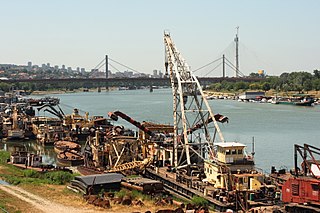
A riverboat is a watercraft designed for inland navigation on lakes, rivers, and artificial waterways. They are generally equipped and outfitted as work boats in one of the carrying trades, for freight or people transport, including luxury units constructed for entertainment enterprises, such as lake or harbour tour boats. As larger water craft, virtually all riverboats are especially designed and constructed, or alternatively, constructed with special-purpose features that optimize them as riverine or lake service craft, for instance, dredgers, survey boats, fisheries management craft, fireboats and law enforcement patrol craft.

Belle of Louisville is a steamboat owned and operated by the city of Louisville, Kentucky, and moored at its downtown wharf next to the Riverfront Plaza/Belvedere during its annual operational period. The steamboat claims itself the "most widely traveled river steamboat in American history." Belle of Louisville's offices are aboard Mayor Andrew Broaddus, and also appears on the list of National Historic Landmarks.

The Delta Queen is an American sternwheel steamboat. She is known for historically cruising the major rivers that constitute the tributaries of the Mississippi River, particularly in the American South. She was docked in Chattanooga, Tennessee and served as a floating hotel until purchased by the newly formed Delta Queen Steamboat Company. She was towed to Houma, Louisiana, in March 2015 for refurbishing to her original condition.
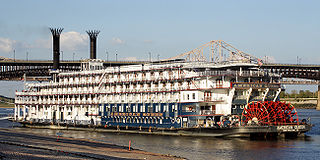
American Queen is said to be the largest river steamboat ever built. The ship was built in 1995 and is a six-deck recreation of a classic Mississippi riverboat, built by McDermott Shipyard for the Delta Queen Steamboat Company. Although the American Queen's stern paddlewheel is indeed powered by a steam plant, her secondary propulsion, in case of an emergency and for maneuverability around tight areas where the paddle wheel can not navigate, comes from a set of diesel-electric propellers known as Z-drives on either side of the sternwheel. She has 222 state rooms for a capacity of 436 guests and a crew of 160. She is 418 feet (127 m) long and 89 feet (27 m) wide.

Natchez has been the name of several steamboats, and four naval vessels, each named after the city of Natchez, Mississippi or the Natchez people. The current one has been in operation since 1975. The previous Natchez were all operated in the nineteenth century, most by Captain Thomas P. Leathers. Each of the steamboats since Leathers' first had as its ensign a cotton bale between its stacks.

Bonnington was a sternwheel steamboat that ran on the Arrow Lakes in British Columbia from 1911 to 1931. Bonnington and two sisterships were the largest sternwheelers ever built in British Columbia. Bonnington was partially dismantled in the 1950s, and later sank, making the vessel the largest freshwater wreck site in British Columbia.
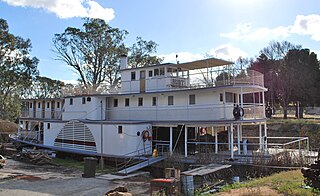
The PS Ruby, also known as the Paddle Steamer Ruby is the flagship of the historic port of Wentworth, New South Wales at the junction of the Murray and Darling Rivers. She is a composite hull paddle steamer that features a 1926 Robey & Co 20 nominal horsepower portable steam engine. Between 1996 and 2007 she was restored to her early 20th-century appearance.

Robert E. Lee, nicknamed the "Monarch of the Mississippi," was a steamboat built in New Albany, Indiana, in 1866. The hull was designed by DeWitt Hill, and the riverboat cost more than $200,000 to build. She was named for General Robert E. Lee, General in Chief of the Armies of the Confederate States. The steamboat gained its greatest fame for racing and beating the then-current speed record holder, Natchez, in an 1870 steamboat race.

Launched in 1850, Lot Whitcomb, later known as Annie Abernathy, was the first steam-powered craft built on the Willamette River in the U.S. state of Oregon. She was one of the first steam-driven vessels to run on the inland waters of Oregon, and contributed to the rapid economic development of the region.

The Rossland was a sternwheel steamboat that ran on the Arrow Lakes in British Columbia. It was named after Rossland, British Columbia, once a prosperous mining town in the region.

Columbia was a sternwheel steamboat that ran on the Arrow Lakes in British Columbia from 1891 to 1894. Columbia should be distinguished from the many other vessels with the same or similar names, including in particular the propeller-driven steamboat Columbia that ran on the Arrow Lakes for many years.
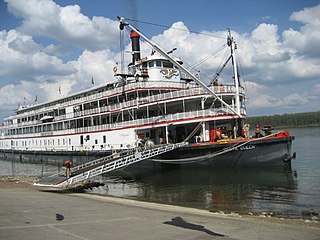
Steamboats played a major role in the 19th-century development of the Mississippi River and its tributaries, allowing practical large-scale transport of passengers and freight both up- and down-river. Using steam power, riverboats were developed during that time which could navigate in shallow waters as well as upriver against strong currents. After the development of railroads, passenger traffic gradually switched to this faster form of transportation, but steamboats continued to serve Mississippi River commerce into the early 20th century. A small number of steamboats are still used for tourist excursions in the 21st century.

Marion was a small sternwheel steamboat that operated in several waterways in inland British Columbia from 1888 to 1901.
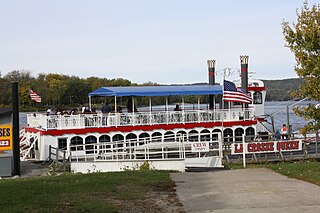
The La Crosse Queen is the name of seven different sightseeing and excursion boats that have operated out of La Crosse, Wisconsin's Riverside Park. The current vessel, La Crosse Queen VII was built in 2008 at Skipperliner Marine on French Island, Wisconsin. The La Crosse Queen VII offers both public and private cruises from its port in Riverside Park. The vessel is U.S. Coast Guard inspected for safety and is licensed to carry up to 149 passengers.

Kuskanook was a wooden, stern-wheel driven steamboat that operated on Kootenay Lake, in British Columbia from 1906 to 1931. After being taken out of service, Kuskanook was sold for use as a floating hotel, finally sinking in 1936. The vessel name is also seen spelled Kooskanook.

International was a stern-wheel driven steam boat that operated on Kootenay Lake in British Columbia from 1896 to 1908. International was owned by a Canadian subsidiary of the Great Northern Railway and was involved in sharp competition, including steamboat racing, with similar vessels owned by the Canadian Pacific Railway.
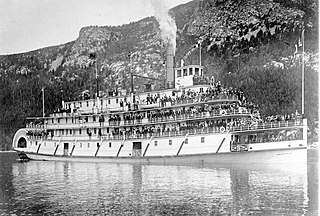
Nasookin was a sternwheel-driven steamboat that operated on Kootenay Lake in British Columbia from 1913 to 1947. Nasookin was one of the largest inland steam vessels ever to operate in British Columbia and the Columbia River and its tributaries. Nasookin became surplus to its original owner, the Canadian Pacific Railway, and was transferred to the British Columbia Provincial government which used it as an auto ferry until 1947. Negligent mooring of the steamer in 1948 led to irreparable damage to its hull, and it was later scrapped. Portions of the upper works were salvaged and used as a house.






















